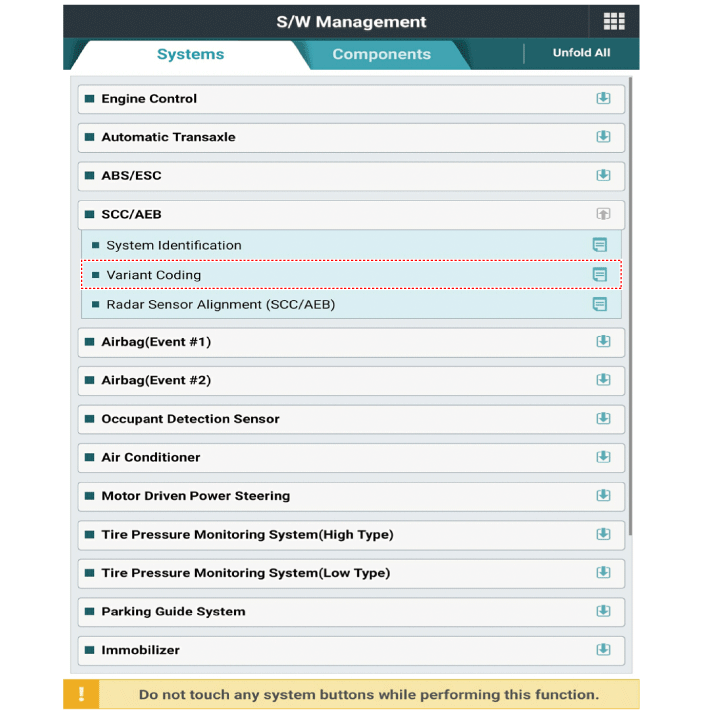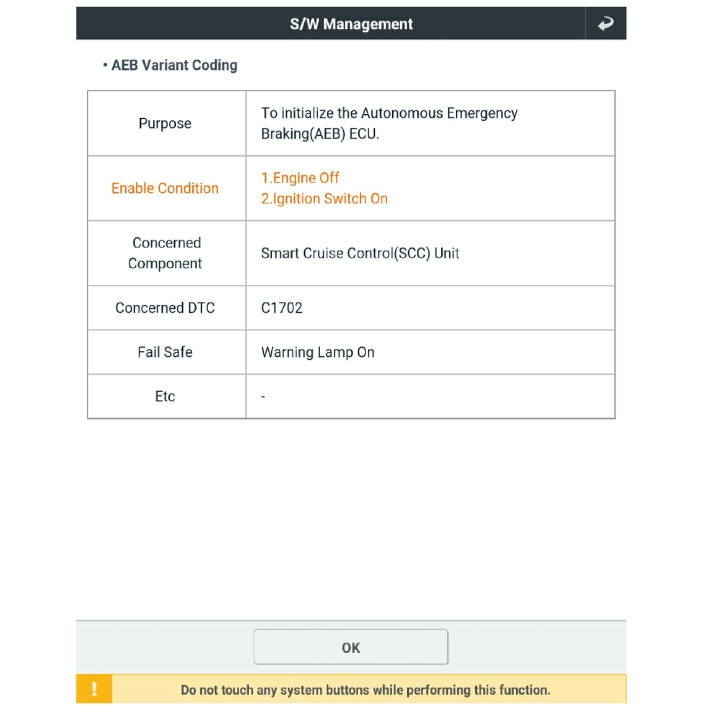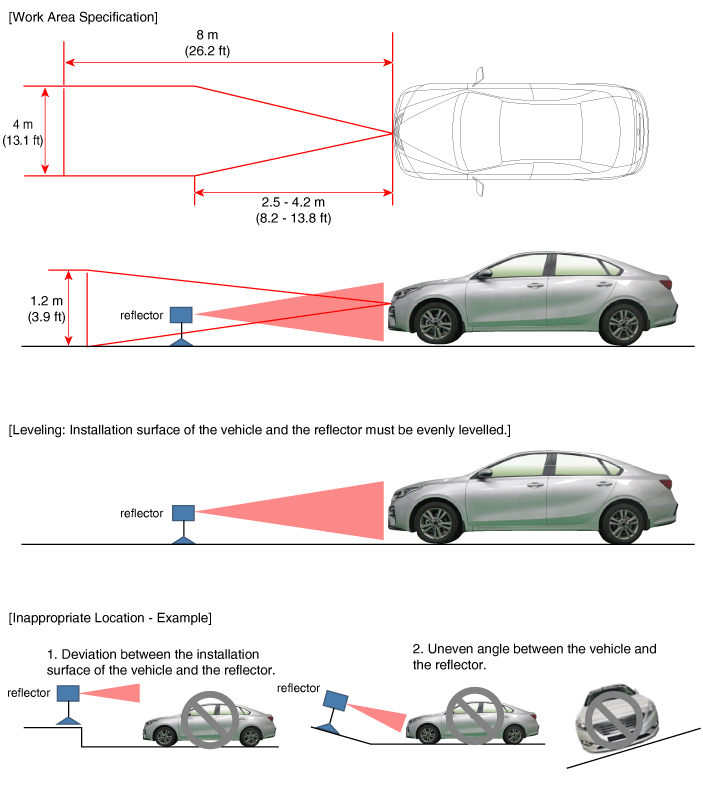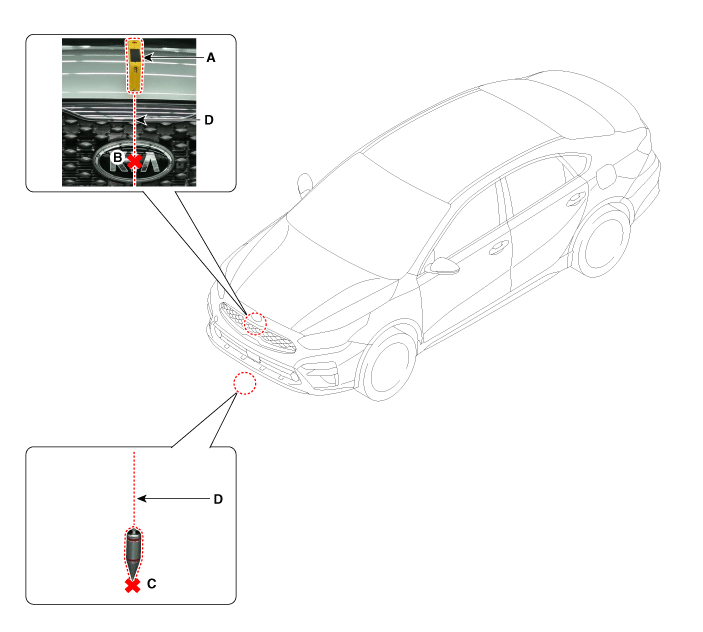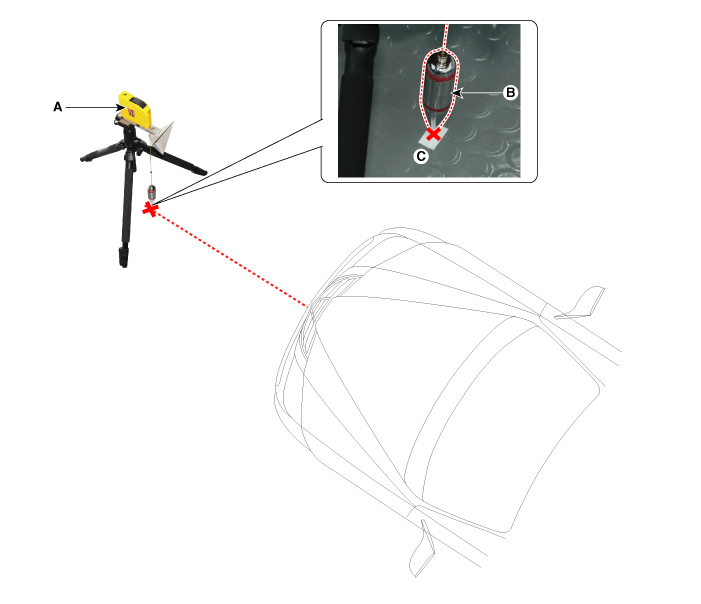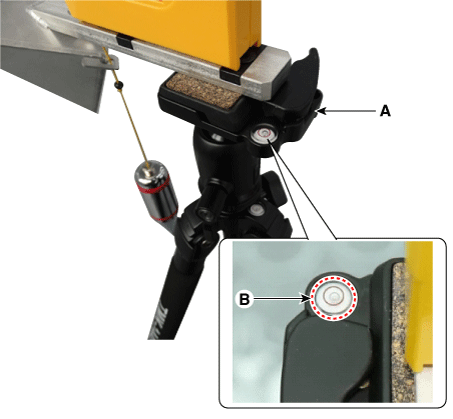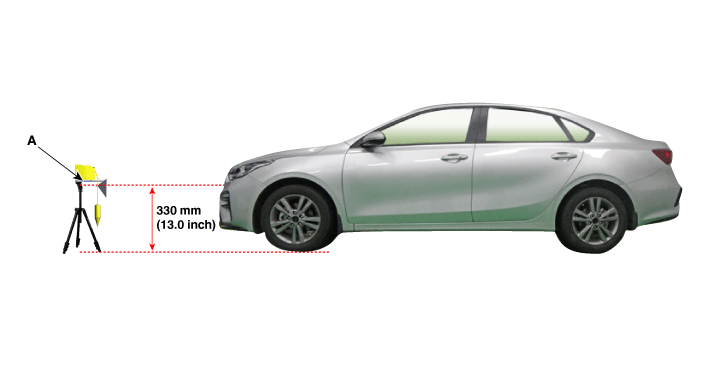Kia Forte: Forward Collision-Avoidance Assist (FCA) System / FCA Radar
Schematic diagrams
| Circuit Diagram |

Repair procedures
| Removal |
SCC & FCA Radar and Unit
| 1. |
Remove the front bumper. (Refer to Body (Interior and Exterior) - "Front Bumper Cover") |
| 2. |
Disconnect the SCC & FCA radar connector (A). |
| 3. |
Remove the SCC & FCA radar (B) after loosening the mounting nuts.
|
SCC & FCA Unit (Australia only)
| 1. |
Remove the main crash pad assembly. (Refer to Body (Interior and Exterior - "Main Crash Pad Assembly") |
| 2. |
Disconnect the SCC & FCA unit connector. |
| 3. |
Remove the SCC & FCA unit (A).
|
| Installation |
SCC & FCA Radar and Unit
| 1. |
Install in the reverse order of removal. |
| 2. |
Align the variant coding procedure. (Refer to Adjustment - "Variant Coding") |
| 3. |
Align the smart cruise control radar sensor. (Refer to Adjustment - "Forward Collision-Avoidance Assist (FCA) Radar Alignment") |
SCC & FCA Unit (Australia only)
| 1. |
Install in the reverse order of removal. |
| 2. |
Align the variant coding procedure. (Refer to Adjustment - "Variant Coding") |
| Adjustment |
Variant Coding
| 1. |
Switch "OFF" the ignition. |
| 2. |
Connect the KDS to Data Link Connector (DLC). |
| 3. |
Switch "ON" the ignition. |
| 4. |
Select "Vehicle, Model year, Engine, System". |
| 5. |
Select "Vehicle S/W Management". |
| 6. |
Perform variant coding.
|
Forward Collision-Avoidance Assist (FCA) Radar Alignment
Forward Collision-Avoidance Assist (FCA) system is designed to help avoid a potential collision or reduce its impact when drivers applies inadequate, delayed or no brakes at all to avoid a collision.
In order for the radar sensor to operate correctly, it must be properly aligned parallel to the driving direction of the vehicle.For this reason, the radar sensor alignment procedure must be carried out whenever the sensor has been reinstalled or replaced with a new one.
If the sensor alignment procedure is not performed in the conditions mentioned above, the smart cruise control system may not operate correctly.
The FCA radar sensor alignment is required when:
|
The sensor can not recognize a vehicle ahead:
|
Forward Collision-Avoidance Assist (FCA) Radar Alignment
| 1. |
Stop the vehicle horizontally at a flat place.
|
| 2. |
Mark the center point of emblem (A) and the center point on top of wind glass (B).
|
| 3. |
Connect the SCC Calibration Laser (SST No. : 09964-C1200) to the tripod (SST No. : 09964-C1300).
|
| 4. |
By using the SCC Calibration Reflector [SST No. : 09964-C1100] (A), adjust the wire (D) so that the center point of emblem (B) and the center point on the ground (C) are perpendicular to each other.
|
| 5. |
Install the vertical/horizontal laser [SST No. : 09964-C1200] (A) at over 4.2m (12.5 ft) to the front of the vehicle.
|
| 6. |
Match the vertical line of laser to (A) and (B) using the vertical/horizontal laser (C) [SST No. : 09964-C1200].
|
| 7. |
Mark (C) at 1.0 - 3.8 m (3.3 - 12.5 ft) from (A) in front of the vehicle.
|
| 8. |
Remove the SCC Calibration Laser [SST No. : 09964-C1200] (B) from the tripod [SST No. : 09964-C1300] (A).
|
| 9. |
Mount the reflector [SST No. : 09964-C1100] (B) onto the tripod [SST No. : 09964-C1300] (A).
|
| 10. |
Align the vertical weight (B) of the SCC Calibration Reflector [SST No. : 09964-C1100] (A) with the point (C).
|
| 11. |
Using the bubble level (B) of the tripod [SST No. : 09964-C1300] (A), set the reflector horizontally.
|
| 12. |
Set the height of the SCC calibration reflector [SST No. : 09964-C1100] (A) to 330 mm (13.0 inch).
|
| 13. |
Check again the radar sensor and the surface of front bumper for the following items with the eyes.
|
| 14. |
Connect the KDS to the DLC of the vehicle and start sensor alignment.
|
| 15. |
After correctly selecting the vehicle model, select "Radar Sensor Alignment" from the auxiliary functions in KDS Menu.
|
| 16. |
Perform sensor alignment by following the directions shown in the KDS monitor.
|
| 17. |
In case of sensor alignment failure, check the alignment conditions. Turn the ignition key OFF, then reperform the sensor alignment procedure. |
| Inspection |
Inspection procedures for Forward Collision-Avoidance Assist (FCA) system failure:
| 1. |
Check the bumper appearance and accident history (visual appearance of the vehicle, maintenance and bumper replacement history). → If the vehicle has been crashed, FCA mounting part is highly likely to be twisted. |
| 2. |
Check whether the radar sensor cover of the bumper is dirty. → If the cover is dirty, FCA is highly likely to be released by the foreign substance during operation. |
| 3. |
After starting engine, check FCA warning message on the cluster and DTC code. (Refer to DTC guide.) |
| 4. |
After starting engine, stop for more than 5 seconds. → If system initialization (yaw rate sensor offset compensation) is not completed, FCA will not operate. |
 Forward Collision-Avoidance Assist (FCA) System
Forward Collision-Avoidance Assist (FCA) System
Description and operation
Description
–
FCA system is designed to help avoid a potential collision or reduce
its impact when drivers applies inadequate, delayed or n ...
 FCA Camera
FCA Camera
Schematic diagrams
Schematic Diagram
Terminal Function
No
Function
1
-
2
IGN_1
...
Other information:
Kia Forte 2019-2025 (BD) Service Manual: Steering Wheel Remote Controller (SWRC)
Components and components location Components 1. Left remote control switch (Audio + Bluetooth + Voice) 2. Right remote control switch (Trip Computer + SCC) Schematic diagrams Circuit Diagram [Audio + Bluetooth + Voice] ...
Kia Forte 2019-2025 (BD) Service Manual: Rear Stabilizer Bar
Repair procedures Removal and Installation 1. Remove the rear wheel and tire (A). Tightening torque : 107.9 - 127.5 N·m (11.0 - 13.0 kgf·m, 79.6 - 94.0 lb·ft) ...



